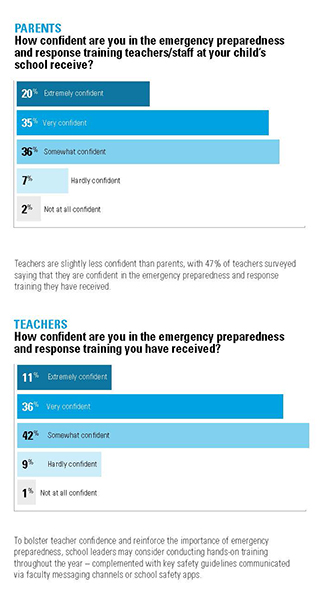New Report Reveals Parents' and Teachers' Critical Perspective on School Safety
- By Kristal Kuykendall
- 08/08/23
A new report from Motorola Solutions reveals parents’ and teachers’ top concerns and how much they know about and are confident in their schools’ safety planning and emergency response preparation.
 The 2023 K–12 School Safety Report captured sentiments from 1,000 parents and 1,000 educators across the United States, asking them about their schools’ emergency preparedness plans, communication practices, school safety technologies, and training for teachers and students.
The 2023 K–12 School Safety Report captured sentiments from 1,000 parents and 1,000 educators across the United States, asking them about their schools’ emergency preparedness plans, communication practices, school safety technologies, and training for teachers and students.
Data from their responses shows that 67% of both parents and teachers are much more concerned about school safety now than they were five years ago, even as 73% of parents and 80% of teachers are confident that their school’s emergency response plans are effective.
“School safety is top of mind for parents and educators alike, with both groups expressing concerns about mental health issues, bullying and active shooter situations,” said Todd Piett, vice president of Rave Mobile Safety at Motorola Solutions. “Ensuring that school personnel and families are aware of proactive planning practices, the notification methods employed by schools, technologies in place to thwart and report emergencies and school protocols for when incidents occur will not only help to alleviate worries, but ultimately improve safety outcomes.”
Motorola Solutions’ survey was conducted in June by independent market research firm Researchscape, according to a news release.
Key Findings
-
Safety planning and awareness of safety preparedness can impactenrollment and staff retention: When considering which school to enroll their children or to accept a job as a teacher, respondents both ranked school safety as a critical factor (66% for parents, 72% for teachers).
-
Student mental health continues to be a top concern: Nearly two-thirds (64%) of parents and 68% of teachers are very or extremely concerned about students’ mental health.
-
Communication channels before a crisis and during a crisis: 48% of teachers said their school offers a method for submitting anonymous or confidential tips to either school leaders, law enforcement, or both, while just 43% of parents said the same.
-
Keeping parents engaged and informed about safety technology: 74% of teachers said their school has adopted new safety technology in the last two years, while 54% of parents reported that they haven’t seen new safety technologies implemented. “This disparity presents an opportunity for schools to periodically communicate with parents about the safety solutions they're implementing to reduce risk or expedite response,” Motorola Solutions’ report said.
-
46% of parents say panic button apps that allow teachers and school staff to quickly notify law enforcement “would increase their confidence in school safety.”
-
89% of parents say their child has participated in a school lockdown drill, with 96% of teachers reporting the same.
-
82% of parents say their child has participated in a drill specifically for active shooter preparedness, while 73% of teachers have participated in such drills with students and another 10% without students.
-
36% of teachers have not engaged in training with first responders but they want to.
Learn more and read the full 2023 K-12 School Safety Report at Motorola’s website.